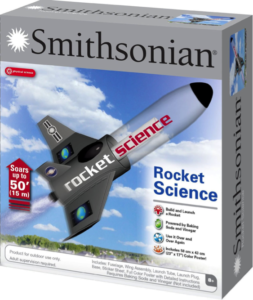Product Review: Smithsonian Rocket Science
 The Smithsonian Rocket Science kit (affiliate link) was an impulse buy- we were at the craft store with a 50% off one item coupon, and what we needed cost all of three dollars. We did a quick check of the science kit section, and once the younger boy (codename: Bulldog) saw the rocket required baking soda and vinegar (as close as he can get to explosives) he was all-in.
The Smithsonian Rocket Science kit (affiliate link) was an impulse buy- we were at the craft store with a 50% off one item coupon, and what we needed cost all of three dollars. We did a quick check of the science kit section, and once the younger boy (codename: Bulldog) saw the rocket required baking soda and vinegar (as close as he can get to explosives) he was all-in.
He likes to do his projects on his own, so I largely ignored him as he pulled everything out of the box, decorated the rocket, and made his way outside to launch. From the kitchen window I saw repeated attempts spill over his hands and fizzle.
“Take seven!” he yelled. “This is science, we don’t quit.”
At take 12, I asked if he’d read the directions. He said yes, and showed me the sheet included with the kit. Load the baking soda into the base, put vinegar in the rocket, shake a few times and watch it soar over two stories high… except following those instructions led to soaked hands and feet, every single time.
Bulldog started to lose his cool. “What a waste of money! Good thing we had that coupon.”
“Maybe there are more instructions on line,” I said. “Let me check.”
And then I read the very many Amazon reviews berating the rocket, the disbelief that the Smithsonian name was slapped onto such an inferior product. But one very helpful person, who also had been through 20 or so trials before getting it right, took the time to write out more extensive instructions, providing the necessary details the included directions had lacked.
To paraphrase:
- Fill the launch tube with baking soda. You can pack it in, some will spill out the side holes, it’s all good.
- Pour the vinegar into the rocket body. Less is definitely more- using the minimum will ultimately allow for more gas to build up, and you’ll have a higher launch.
- Tipping the rocket slightly down, insert the tube and press the rocket tightly on the rubber stopper. You need a tight seal for this to work and allow the pressure to build up.
- Give the assembled rocket and base a few quick shakes, then step away. You should have a successful launch, but it still might take a few tries to get the hang of it.
Once Bulldog figured it out, this was his favorite thing to do for a few weeks. He successfully killed large patches of grass with spilled vinegar, but I’m sure it was bound to die once the heat of July set in anyway. And he learned first hand about the effects of pressure build up, why sometimes it pays to stray from provided directions, and the importance of perseverance in the face of repeated failures.
If Thomas Edison had quit, would we have lightbulbs?
Overall, I give Smithsonian Rocket Science 4 out of 5 stars (because, after all, it did kill the grass.) Are the directions poor? Yes. But because they were, we had to put in more effort figure it out and he learned how and why it worked… and that tinkering and perseverance mean trying different ways to accomplish your goal each time.
As Edison said, “I have not failed. I’ve just found 10,000 ways that won’t work.”
